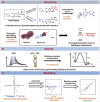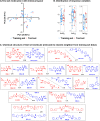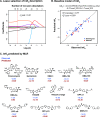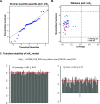Quantitative Structure-Activity Relationship (QSAR) Study Predicts Small-Molecule Binding to RNA Structure
- PMID: 35522972
- PMCID: PMC9150105
- DOI: 10.1021/acs.jmedchem.2c00254
Quantitative Structure-Activity Relationship (QSAR) Study Predicts Small-Molecule Binding to RNA Structure
Abstract
The diversity of RNA structural elements and their documented role in human diseases make RNA an attractive therapeutic target. However, progress in drug discovery and development has been hindered by challenges in the determination of high-resolution RNA structures and a limited understanding of the parameters that drive RNA recognition by small molecules, including a lack of validated quantitative structure-activity relationships (QSARs). Herein, we develop QSAR models that quantitatively predict both thermodynamic- and kinetic-based binding parameters of small molecules and the HIV-1 transactivation response (TAR) RNA model system. Small molecules bearing diverse scaffolds were screened against TAR using surface plasmon resonance. Multiple linear regression (MLR) combined with feature selection afforded robust models that allowed direct interpretation of the properties critical for both binding strength and kinetic rate constants. These models were validated with new molecules, and their accurate performance was confirmed via comparison to ensemble tree methods, supporting the general applicability of this platform.
Conflict of interest statement
The authors declare no competing financial interest.
Figures






Similar articles
-
On various metrics used for validation of predictive QSAR models with applications in virtual screening and focused library design.Comb Chem High Throughput Screen. 2011 Jul;14(6):450-74. doi: 10.2174/138620711795767893. Comb Chem High Throughput Screen. 2011. PMID: 21521150 Review.
-
Predicting human intestinal absorption of diverse chemicals using ensemble learning based QSAR modeling approaches.Comput Biol Chem. 2016 Apr;61:178-96. doi: 10.1016/j.compbiolchem.2016.01.005. Epub 2016 Jan 29. Comput Biol Chem. 2016. PMID: 26881740
-
Prediction of Activities of BRAF (V600E) Inhibitors by SW-MLR and GA-MLR Methods.Curr Comput Aided Drug Des. 2017;13(3):249-261. doi: 10.2174/1573409913666170303113812. Curr Comput Aided Drug Des. 2017. PMID: 28260510
-
Face-time with TAR: Portraits of an HIV-1 RNA with diverse modes of effector recognition relevant for drug discovery.J Biol Chem. 2019 Jun 14;294(24):9326-9341. doi: 10.1074/jbc.REV119.006860. Epub 2019 May 12. J Biol Chem. 2019. PMID: 31080171 Free PMC article. Review.
-
Application of GA-MLR for QSAR Modeling of the Arylthioindole Class of Tubulin Polymerization Inhibitors as Anticancer Agents.Anticancer Agents Med Chem. 2017;17(4):552-565. doi: 10.2174/1871520616666160811162105. Anticancer Agents Med Chem. 2017. PMID: 27528182
Cited by
-
Mechanistic Studies of Small Molecule Ligands Selective to RNA Single G Bulges.bioRxiv [Preprint]. 2024 Oct 17:2024.10.14.618236. doi: 10.1101/2024.10.14.618236. bioRxiv. 2024. Update in: Nucleic Acids Res. 2025 Jun 20;53(12):gkaf559. doi: 10.1093/nar/gkaf559. PMID: 39464119 Free PMC article. Updated. Preprint.
-
Three- and four-stranded nucleic acid structures and their ligands.RSC Chem Biol. 2025 Feb 19;6(4):466-491. doi: 10.1039/d4cb00287c. eCollection 2025 Apr 2. RSC Chem Biol. 2025. PMID: 40007865 Free PMC article. Review.
-
Harnessing Computational Approaches for RNA-Targeted Drug Discovery.RNA Nanomed. 2024 Dec;1(1):1-15. doi: 10.59566/isrnn.2024.0101001. RNA Nanomed. 2024. PMID: 40201452 Free PMC article.
-
De Novo Generation and Identification of Novel Compounds with Drug Efficacy Based on Machine Learning.Adv Sci (Weinh). 2024 Mar;11(11):e2307245. doi: 10.1002/advs.202307245. Epub 2024 Jan 10. Adv Sci (Weinh). 2024. PMID: 38204214 Free PMC article.
-
Hydroxyl-Directed Regio- and Diastereoselective Allylic Sulfone Reductions with [Sm(H2O)n]I2.J Org Chem. 2024 Jan 5;89(1):692-700. doi: 10.1021/acs.joc.3c01647. Epub 2023 Dec 13. J Org Chem. 2024. PMID: 38091512 Free PMC article.
References
-
- Ji Q.; Zhang L.; Liu X.; Zhou L.; Wang W.; Han Z.; Sui H.; Tang Y.; Wang Y.; Liu N.; Ren J.; Hou F.; Li Q. Long Non-Coding RNA MALAT1 Promotes Tumour Growth and Metastasis in Colorectal Cancer through Binding to SFPQ and Releasing Oncogene PTBP2 from SFPQ/PTBP2 Complex. Br. J. Cancer 2014, 111, 736–748. 10.1038/bjc.2014.383. - DOI - PMC - PubMed
-
- Gupta R. A.; Shah N.; Wang K. C.; Kim J.; Horlings H. M.; Wong D. J.; Tsai M.-C.; Hung T.; Argani P.; Rinn J. L.; Wang Y.; Brzoska P.; Kong B.; Li R.; West R. B.; van de Vijver M. J.; Sukumar S.; Chang H. Y. Long Non-Coding RNA HOTAIR Reprograms Chromatin State to Promote Cancer Metastasis. Nature 2010, 464, 1071–1076. 10.1038/nature08975. - DOI - PMC - PubMed
Publication types
MeSH terms
Substances
Grants and funding
LinkOut - more resources
Full Text Sources
Other Literature Sources

